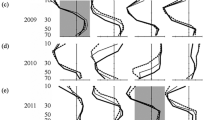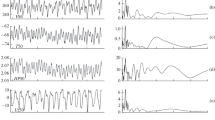Abstract
Using the longest and most reliable ozonesonde data sets grouped for four regions (Japan, Europe, as well as temperate and polar latitudes of Canada) the comparative analysis of regional responses of ozone, temperature, horizontal wind, tropopause and surface pressure on the equatorial quasi-biennial oscillation (QBO effects), manifesting in opposite phases of the 11-year solar cycle (11-yr SC) was carried out. The impact of solar cycle is found to be the strongest at the Canadian Arctic, near one of two climatological centres of polar vortex, where in solar maximum conditions the QBO signals in ozone and temperature have much larger amplitudes, embrace greater range of heights, and are maximized much higher than those in solar minimum conditions. The strengthening of the temperature QBO effect during solar maxima can explain why correlation between the 11-yr SC and polar winter stratospheric temperature is reversed in the opposite QBO phases. At the border of polar vortex the 11-yr SC also modulates the QBO effect in zonal wind, strengthening the quasi-biennial modulation of polar vortex during solar maxima that is associated with strong negative correlation between stratospheric QBO signals in zonal wind and temperature. Above Japan the QBO effects of ozone, temperature, and zonal wind, manifesting in solar maxima reveal the downward phase dynamics, reminding similar feature of the zonal wind in the equatorial stratosphere. Above Europe, the QBO effects in solar maxima reveal more similarity with those above Japan, while in solar minima with the effects obtained at the Canadian middle-latitude stations. It is revealed that the 11-yr SC influences regional QBO effects in tropopause height, tropopause temperature and surface pressure. The influence most distinctly manifest itself in tropopause characteristics above Japan. The results of the accompanying analysis of the QBO reference time series testify that in the period of 1965–2006 above 50-hPa level the duration of the QBO cycle in solar maxima is 1–3 months longer than in solar minima. The differences are more distinct at higher levels, but they are diminished with lengthening of the period.








Similar content being viewed by others
References
Baldwin MP, Dunkerton TJ (2005) The solar cycle and stratosphere–troposphere coupling. J Atmos Terr Phys 67:71–82. doi:10.1016/j.jastp.2004.07.018
Barnes RA, Bandy AR, Torres AL (1989) Electrochemical concentration cell ozonesonde accuracy and precision. J Geophys Res 90:7881–7887
Brewer AW, Milford JR (1960) The Oxford-Kew ozone sound. Proc R Soc Lond Ser A 256:470–495
Chipperfield MP, Kinnersley JS, Zawodny J (1994) A two dimensional model study of the QBO signal in SAGE II NO2 and O3. Geophys Res Lett 21:589–592
Cordero EC, Nathan TR (2005) A new pathway for communicating the 11-year solar cycle signal to the QBO. Geophys Res Lett 32:L18805. doi:10.1029/2005GL023696
Crooks SA, Gray LJ (2005) Characterization of the 11-year solar signal using a multiple regression analysis of the ERA-40 dataset. J Clim 18:996–1015
De Backer H, De Muer D, De Sadelaer G (1998) Comparison of ozone profiles obtained with Brewer-Mast and Z-ECC sensors during simultaneous ascents. J Geophys Res 103:19641–19648
Dunkerton TJ (2000) Midwinter deceleration of the subtropical mesospheric jet and interannual variability of the high-latitude flow in UKMO analysis. J Atmos Sci 57:3838–3858
Geller MA, Alpert JC (1980) Planetary wave coupling between the troposphere and middle atmosphere as possible sun–weather mechanism. J Atmos Sci 37:1197–1215
Gray LJ (2003) The influence of the equatorial upper stratosphere on stratospheric sudden warmings. Geophys Res Lett 30:doi:10.1029/2002GL016430
Gray LJ, Crooks SA, Pascoe C, S Sparrow S., Palmer M (2004) Solar and QBO influences on the timings of stratospheric sudden warmings. J Atmos Sci 61:2777–2796
Haigh JD (2003) The effects of solar variability on the Earth’s climate. Phil Trans R Soc Lond Ser A 125:872–892
Haigh JD, Austin J, Butchart N, Chanin M-L, Crooks S, Gray LJ, Halenka T, Hampson J, Hood LL, Isaksen ISA, Keckhut P, Labitzke K, Langematz U, Matthes K, Palmer M, Rognerud MB, Tourpali K, Zerefos C (2004) Solar variability and climate: selected results from the SOLICE project. SPARC Newsletter. 23
Hamilton K (1989) Interhemispheric asymmetry and annual synchronization of the ozone quasi-biennial oscillation. J Atmos. Sci 46:1019–1025
Hamilton K (2002) On the quasi decadal modulation of the stratospheric QBO period. J Clim 15:2562–2565
Hampson J, Keckhut P, Hauchecorne A, Chanin ML (2005) The effect of the 11-year solar-cycle on the temperature in the upper-stratosphere and mesosphere––Part II: numerical simulations and the role of planetary waves. J Atmos Sol Terr Phys 67:948–968
Hampson J, Keckhut P, Hauchecorne A, Chanin ML (2006) The effect of the 11-year solar-cycle on the temperature in the upper-stratosphere and mesosphere––Part III: investigations of zonal asymmetry. J Atmos Sol Terr Phys 68:1591–1599
Holton JR (1975) The dynamic meteorology of the stratosphere and mesosphere. Meteorological Monogr 15:No 2
Holton JR, Tan HC (1982) The influence of the equatorial quasi-biennial oscillation on the global circulation at 50 mbar. J Atmos Sci 37:2200–2208
Keckhut P, Cagnazzo C, Chanin M-L, Claud C, Hauchecorne A (2005) The 11-year solar-cycle effects on temperature in the upper stratosphere and mesosphere. Part I: Assessment of observations. J Atmos Sol Terr Phys 67:940–947
Kinnersley JS, Tung KK (1999) Mechanisms for extratropical QBO in circulation and ozone. J Atmos Sci 56:1942–1962
Kodera K, Kuroda Y (2002) Dynamical response to the solar cycle. 107(D24):4749. doi:10.1029/2002JD002224
Komhyr WD (1969) Electrochemical concentration cell gas analysis. Ann Geophys 25:203–210
Labitzke K (1987) Sunspots, the QBO, and the stratospheric temperature in the north polar region. Geophys Res Lett 14:535–537
Labitzke K (2001) The global signal of the 11-year sunspot cycle in the stratosphere: differences between solar maxima and minima. Meteor Z 10(2):83–90
Labitzke K (2003) The global signal of the 11-year sunspot cycle in the atmosphere: When do we need the QBO? Meteorolog. Zeitschrift 12(4):209–216
Labitzke K (2004) On the signal of the 11-year sunspot cycle in the stratosphere and its modulation by the quasi biennial oscillation. J Atmos Sol Terr Phys 66:1151–1157
Labitzke K, van Loon H (1988) Associations between the 11-year solar cycle, the QBO and the atmosphere, Part I: the troposphere and stratosphere in the northern hemisphere winter. J Atmos Terr Phys 50:197–206
Lee H, Smith AK (2003) Simulation of the combined effects of solar cycle, quasi-biennial oscillation, and volcanic forcing on stratospheric ozone changes in recent decades. J Geophys Res 108(D2):4049. doi:10.1029/2001JD001503
Matthes K, Langematz U, Gray LJ, Kodera K, Labitzke K (2004) Improved 11-year solar signal in the Freie Universität Berlin climate middle atmosphere model (FUBCMAM). J Geophys Res. doi:10.1029/2003/D004012
Mayr HG, Mengel JG, Wolff CL, Porter HS (2006) QBO as potential amplifier of solar cycle influence. Geophys Res Lett 33:L05812.doi:10.1029/2005GL025650
McCormack JP (2003) The influence of the 11-year solar cycle on the quasi-biennial oscillation. Geophys Res Lett 30(22):2162. doi:10.1029/ 2003GL018314
Naito Y, Yoden S (2005) A statistical analysis on the effects of the equatorial QBO on the extratropical stratosphere and troposphere based on large samples of daily data. Scientific online letters on the atmosphere (SOLA) 1:17–20. doi:10.2151/sola.2005-005
Naujokat B (1986) An update of the observed quasi-biennial oscillation of the stratosphere winds over the tropics. J Atmos Sci 43:1873–1877
Panofsky HA, Brier GW (1958) Some applications of statistics to meteorology. The Pennsylvania State University. University Park, 224 pp
Pascoe CL, Gray LJ, Crooks SA, Jukes MN, Baldwin MP (2005) The quasi-biennial oscillation: analysis using ERA-40 data. J Geophys Res 110:D08105. doi: 10.1029/2004JD004941
Randel WJ, Wu F, Swinbank R, Nash J, O’Neill A (1999) Global QBO circulation derived from UKMO stratospheric analyses. J Atmos Sci 56:457–474
Ruzmaikin A, Feynman J, Jiang X, Yung YL (2005) Extratropical signature of the quasi-biennial oscillation. J Geophys Res 110:D11111. doi: 10.1029/2004JD005382
Salby M, Callaghan P (2000) Connection between the solar cycle and the QBO: the missing link. J Clim 13:2652–2662
Salby M, Callaghan P (2006) Relationship of the quasi-biennial oscillation to the stratospheric signature of the solar cycle. J Geophys Res 111:D06110. doi: 10.1029/2005JD006012
Sitnov SA (2004) QBO effects manifesting in ozone, temperature, and wind profiles. Ann Geophys 22:1495–1512
Soukharev BE, Hood LL (2001) Possible solar modulation of the equatorial quasi-biennial oscillation: additional statistical evidence. J Geophys Res 106(D14):14855–14868
van Loon H, Labitzke K (2000) The influence of the 11-year solar cycle on the stratosphere below 30 km: a review. Space Sci Rev 94:259–278
Tung KK, Yang H (1994) Global QBO in circulation and ozone, I, Reexamination of observational evidence. J Atmos Sci 51:2699–2707
Acknowledgments
The author wish to acknowledge two anonymous reviewers for critical remarks and helpful comments on this paper. The updated QBO data were kindly supplied by Dr. Barbara Naujokat. This work was supported by RFBR grant 08–05-01029.
Author information
Authors and Affiliations
Corresponding author
Rights and permissions
About this article
Cite this article
Sitnov, S.A. Influence of the 11-year solar cycle on the effects of the equatorial quasi-biennial oscillation, manifesting in the extratropical northern atmosphere. Clim Dyn 32, 1–17 (2009). https://doi.org/10.1007/s00382-007-0362-6
Received:
Accepted:
Published:
Issue Date:
DOI: https://doi.org/10.1007/s00382-007-0362-6




